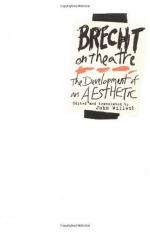
|
| Name: _________________________ | Period: ___________________ |
This test consists of 5 multiple choice questions, 5 short answer questions, and 10 short essay questions.
Multiple Choice Questions
1. What does Brecht call people who came to the theatre to get their cockles warmed in "Conversations with Bert Brecht"?
(a) Scum.
(b) Pot ash.
(c) Vegetation.
(d) Nobility.
2. _____ is a collection of Brecht's theoretical writings published by Surhkamp.
(a) Arbeitsbuch.
(b) Schriften zum Theater.
(c) Versuche.
(d) Stucke.
3. Die Mutter is based on whose novel, Mother?
(a) Penderecki.
(b) Gorki.
(c) Goedel.
(d) Chaplin.
4. Who wrote the play Fruhlingserwachen that helped Peter Lorre make a name for himself?
(a) Korres.
(b) Brecht.
(c) Shaw.
(d) Wedekind.
5. What is the name of the book that contains Walter Nubel Brecht's bibliography that lists Berthold Brecht's works?
(a) Zwei und Zwanzig Arbeiten.
(b) Zinn und Arbeit.
(c) Sinn und Form.
(d) Bloch und Fahber.
Short Answer Questions
1. Where did Brecht give an explanation of Ber Flug der Lindberghs in 1929?
2. What does Brecht praise Georg Kaiser for?
3. The translator's notes in number 37 give a provisional account of the most important of Brecht's _____.
4. What were the left-wing Socialists called in Brecht's time?
5. Brecht states that concern with subject and concern with form are _____.
Short Essay Questions
1. How does Brecht compare his relationship with art and science?
2. How was Piscator's influence obvious to Brecht in theatre in 1929?
3. What advantages did Brecht feel the theatre had in Germany before he went into exile?
4. What is the relationship between a theatre and a play?
5. What did Brecht see as the role of Fate in film?
6. How were theatrical productions in Russia, America and Germany similar to each other in Brecht's time.
7. Why did the editor thank the people he did?
8. What was theatre like and what was the flaw that young people found in theatre after World War I?
9. Why does Brecht use the example of 'leave-taking' in "A Dialogue about Acting" and what does he mean by it?
10. What innovations happened as a result of writing the book?
|
This section contains 649 words (approx. 3 pages at 300 words per page) |

|




